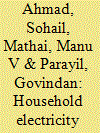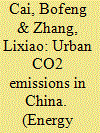|
|
|
Sort Order |
|
|
|
Items / Page
|
|
|
|
|
|
|
| Srl | Item |
| 1 |
ID:
127886


|
|
|
|
|
| Publication |
2014.
|
| Summary/Abstract |
The number of multi-family housing complexes (MFHCs) over 15 yr old in South Korea is expected to exceed 5 million by 2015. Accordingly, the demand for energy retrofit in the deteriorating MFHCs is rapidly increasing. This study aimed to develop a decision support model for establishing the optimal energy retrofit strategy for existing MFHCs. It can provide clear criteria for establishing the carbon emissions reduction target (CERT) and allow efficient budget allocation for conducting the energy retrofit. The CERT for "S" MFHC, one of MFHCs located in Seoul, as a case study, was set at 23.0% (electricity) and 27.9% (gas energy). In the economic and environmental assessment, it was determined that scenario #12 was the optimal scenario (ranked second with regard to NPV40 (net present value at year 40) and third with regard to SIR40 (saving to investment ratio at year 40). The proposed model could be useful for owners, construction managers, or policymakers in charge of establishing energy retrofit strategy for existing MFHCs. It could allow contractors in a competitive bidding process to rationally establish the CERT and select the optimal energy retrofit strategy. It can be also applied to any other country or sector in a global environment.
|
|
|
|
|
|
|
|
|
|
|
|
|
|
|
|
| 2 |
ID:
127944


|
|
|
|
|
| Publication |
2014.
|
| Summary/Abstract |
ACM, Active Community Member, person that takes the initiative to fill out an application on behalf of a community; Seed, randomly selected ACM that allowed us to start collecting information; Ego, person that is interviewed. An Ego can also be an Alter, if it is mentioned by another Ego; Alter, people that provided (Type 1) or received (Type 2) information, as recalled by the Ego; Type 1 edge, an information flow in which an Alter provides information to an Ego; Type 2 edge, an information flow in which an Ego provides information to an Alter; Student, a person whose main occupation is to go to school; Radio, a message spread through the radio. Usually local stations in which an individual is interviewed; Internet, information about the stoves posted on Proyecto Mirador's Website; Maquila, a person that works at a factory for an international company, textile and food processing factories are usual; Agriculture, a peasant that works on agriculture, regardless of land tenancy; Health, a nurse, doctor or other health worker; Church, a priest, nun, minister or person who works as a minister of a faith; Education, a person who works as a school teacher or university professor; PM or PM associates, direct employees of Proyecto Mirador and its Implementers; Other NGO, a person that works on other non-governmental organizations. For example, Peace corps, Hivueras, Plan Honduras; Local, a local leader that has an appointment in the community but does not receive a monetary compensation. For example, members of the water board, village councils; Housewife, a woman whose main occupation is to keep the house; Business, a person that does commerce or services, includes people that sell food informally, artisans, masons, etc.; Government, a person who works directly for the government (except education and health practitioners); PM employees, direct employees without the implementers
|
|
|
|
|
|
|
|
|
|
|
|
|
|
|
|
| 3 |
ID:
132665


|
|
|
|
|
| Publication |
2014.
|
| Summary/Abstract |
According to the 2011 Census of India, over 31% of India×s 1.2 billion people lived in nearly 8000 towns and cities; the remaining 830 million people lived in over 638,000 villages. About 55% of rural households and 93% of urban households had access to electricity. The 2005 Indian Human Development Survey showed that on average, electricity availability (hours of supply per day) in rural and urban households were 14 and 19 h, respectively ( Desai et al., 2007). Using nationally representative data from Indian Human Development Survey, this study estimated the impact of electricity access and availability on two attributes of human well-being, viz. education and health attainment. It found a significant positive relationship between electricity availability and well-being in rural and urban households. Electricity accessibility, revealed a significant positive relationship only for rural households. The paper concludes with implications for electricity policy and infrastructure choices.
|
|
|
|
|
|
|
|
|
|
|
|
|
|
|
|
| 4 |
ID:
128033


|
|
|
|
|
| Publication |
2014.
|
| Summary/Abstract |
Different names/concepts and therefore different spatial boundaries for cities in China are responsible for the conflicting and confusing results associated with urban CO2 emissions accounting. In this study, four types of urban boundaries, i.e., city administrative boundary (UB1), city district boundary (UB2), city built-up area (UB3) and urban proper (UB4), were identified and defined. Tianjin was subsequently selected as the case city to illustrate the different performances of CO2 emissions with respect to these four boundaries using a 1-km grid dataset built bottom-up by point-emission sources. Different urban boundaries can induce a difference in CO2 emissions as large as 654%. UB1 and UB2 are not the appropriate proxies for urban boundaries in the analysis of urban CO2 emissions, although UB1 is a widely adopted boundary. UB3 is a good representative of city clusters and urban sprawl in a certain region, whereas UB4 is the appropriate system boundary for such issues as urban CO2 emissions in light of landscape characteristics and pertinent human activities, as well as the comparability to counterparts in developed countries. These results provide sound policy implications for the improvement of urban energy management and carbon emission abatement in China.
|
|
|
|
|
|
|
|
|
|
|
|
|
|
|
|
|
|
|
|
|